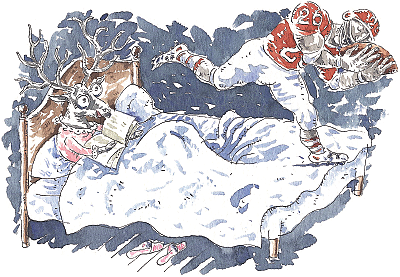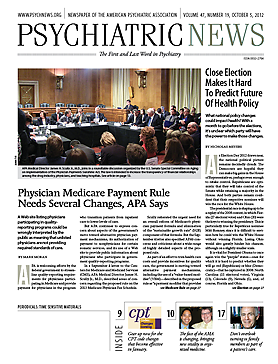It’s amazing what some people do while they’re asleep, sleep-disorder experts say.
They talk, scream, gesticulate, attempt to have sex, leap out of bed, raid the refrigerator, drive cars, and even attempt to kill their spouses. The official name for such abnormal behaviors is “parasomnias” (see "How Parasomnias Can Be Manifest" below).
Although traditionally scientists paid little heed to parasomnias, they have taken more interest in them during the past quarter-century and have learned some valuable things about them, especially during the last 10 years.
“One of those things is that sleep and wakefulness can coexist,” Karl Doghramji, M.D., a professor of psychiatry at Thomas Jefferson University and medical director of the Jefferson Sleep Disorders Center, said in an interview. “Another is the understanding that different sleep states have different types of mentation. We used to think that during REM sleep, people have dreams, cognitive experiences, and emotional experiences, but that in non-REM sleep, people have sort of a blank mind. We now know that in certain non-REM parasomnias, such as sleepwalking and sleep talking, people engage in complex behaviors that are seemingly very purposeful or goal directed.”
These discoveries, he pointed out, “tie in very nicely with the concept of the unconscious that Freud and many others championed many years ago.”
It is also now known that the non-REM parasomnias, such as sleepwalking and sleep talking, tend to run in families, Dimitri Markov, M.D., an assistant professor of psychiatry at Thomas Jefferson University and a sleep specialist, said during an interview. “So people who have [these behaviors] in the family are apt to think that they are normal.” Moreover, sleep deprivation and sleep apnea can trigger sleepwalking, at least in those genetically predisposed to it, he noted.
Sleepwalking is likewise more common than previously thought, Maurice Ohayon, M.D., D.Sc., Ph.D., a professor of psychiatry at Stanford University and a sleep specialist, and his colleagues reported in the May 15 Neurology. They used a large, representative sample of the U.S. population for their study and found that 3.6 percent of the sample reported at least one episode of sleepwalking in the previous year. “This 3.6 percent represents 8.5 million Americans,” he told Psychiatric News. “That is considerable…. Narcolepsy [by contrast affects] 0.04 percent of the population.”
For Carlos Schenck, M.D., a professor of psychiatry at the University of Minnesota, September 11, 1982, was special for several reasons. He not only started his sleep-medicine career on that day, but also encountered an unusual case. It was a 67-year-old man who had charged out of bed thinking he was a football player and who had crashed into his dresser. This led to Schenck and his colleagues discovering a parasomnia that hadn’t been known before. They named it “REM sleep behavior disorder.”
“And then we discovered more men, particularly middle-aged and older men, acting out these violent dreams.” Schenck said during an interview. “These men were all pleasant individuals, married for decades before they developed this disorder. Their wives could attest to the fact that there was no tendency for irritability or anger or anything like that. They would have noticed it after being married for 20, 30, or 40 years.”
“Today, probably more is known about REM sleep behavior disorder than all the other parasomnias,” John Winkelman, M.D., an associate professor of psychiatry at Harvard Medical School and a sleep specialist, told Psychiatric News.
For instance, the disorder afflicts mostly elderly men and may precede Parkinson’s disease or Lewy body dementia by five, 10, or 15 years, Markov reported, although sometimes the Parkinson’s disease or dementia may manifest itself first and then the REM sleep behavior disorder follows. Although not all older men who have the disorder will develop Parkinson’s or dementia, “the numbers could be as high as 50 percent,” Markov said.
“Some preliminary epidemiological studies indicate that 0.5 percent of men have the disorder,” Schenck added. “However, most of us in the field really believe that in men in the older age groups” the prevalence could range from 1 percent to 5 percent.
And then in 1991, Schenck and his colleagues identified sleep-related eating disorder, which is a non-REM parasomnia, and in 1997 wrote a major review article about another non-REM parasomnia that others had identified. It was sexsomnia—abnormal sexual behavior during sleep. Today, scientists know that sexsomnia sometimes occurs in people with a history of sleepwalking and of sleep terrors, said Schenck. But they also believe that sleep apnea can trigger it.
Still, a lot more needs to be learned about parasomnias, experts concur.
n
For example, several studies have suggested that an antihypertensive medication can reduce the frequency and intensity of nightmares in veterans with posttraumatic stress disorder, Winkelman stated, but “we don’t have good insights into the biology of nightmares.” The same holds regarding the biology of sleepwalking, night terrors, sleep-related eating disorder, and other parasomnias, he said.
“We know that psychiatric medications can trigger REM sleep behavior disorder,” said Schenck. “We know that sleeping pills can trigger sleep-related eating. But basically we need to know the whole range of conditions that can predispose people to a variety of parasomnias.”
So what new knowledge about parasomnias might be emerging during the next decade or so?
“We are coming a bit closer, I think, to identifying some of the genetic predispositions of non-REM parasomnias,” said Doghramji. “Work is being done with some of the folks who have these disorders to understand familial tendencies and genetic predispostions. In the next decade, I hope that we’ll also be able to identify which subpopulation of REM sleep behavior disorder patients goes on to develop Parkinson’s disease or other neurodegenerative brain disorders. And hopefully we will be able to predict which patients with the disorder should receive treatment prophylactically with dopa-mine medications or other medications before the problem becomes full-blown” (see "Parasomnias Rarely Related to Psychiatric Illness" below).
“I think we will learn more about the abnormal brain physiology triggering the parasomnias,” Schenck predicted. And one reason why, he explained, is that high-density EEG machines are now becoming available. For example, “at the University of Wisconsin, Madison, they are using 156-electrode EEGs—that is an enormous amount. Ordinarily we use only four electrodes. To study parasomnias in a sleep lab, it could be eight to 12. But to have 156 electrodes, you can really go deep into the brain … to discover the origins of parasomnias.”

How Parasomnias Can Be Manifest
One of the most dramatic parasomnia cases that Karl Doghramji, M.D., a professor of psychiatry at Thomas Jefferson University and medical director of the Jefferson Sleep Disorders Center, has been involved in, he said during an interview, concerned a man in his 60s—“Roger.”
Roger and his wife went to bed. A female friend of his wife was sleeping in another area of the house. He woke up hearing screaming and thought that there was a fire. But then he realized that his wife’s friend was screaming, “Get him off of me!” When he came to, he realized that he was lying on top of her. Being a religious man, he was devastated by what he had done.
Yet other strange behaviors had happened before, it turned out. For example, his wife had often found him sleeping in the bathtub or in the kitchen at 4 o’clock in the morning, cooking his shoes in a skillet instead of eggs. He had also been caught taking nighttime drives in his underwear.
Roger clearly had a sleepwalking parasomnia, Doghramji said.
Another case, Doghramji reported, concerned a victim of sleep-related eating disorder—“Terry.” Terry made an appointment to see him and his colleagues because of a problem with weight gain and daytime sleepiness. Terry said that he slept well at night, but what was bizarre, he admitted, was that when he woke up in the morning, candy wrappers were strewn all over his bedroom.
Doghramji and his team installed a video camera in Terry’s bedroom to find out what was transpiring at night. The camera documented that on a nightly basis, Terry was making his way to the kitchen and raiding the refrigerator—drinking half a gallon of milk, eating butter, and making an incredible mess.
The most famous parasomnia patient whom Carlos Schenck, M.D., a professor of psychiatry at the University of Minnesota, has encountered was written up by National Geographic in 1990. So the story of this patient—Mel Abel—is in the public domain, he said.
Abel had a dream one night in which he shot a deer. But the deer didn’t die right away, so Abel wanted to put it out of its misery. He put his hands around the deer’s neck to snap it. But then Mel heard his wife screaming and came to; he had put his hands around her neck and was about to snap it. “He cried inconsolably for a long time afterward because he could have killed her,” Schenck recalled. “And that was one of the main reasons he came to us for help. I am sure that a number of men with REM sleep behavior disorder, like Mel, have inadvertently almost killed their wives or indeed have killed their wives in a tragic way.”
Parasomnias Rarely Related to Psychiatric Illness
One of the most crucial facts that psychiatrists should know about parasomnias, experts stressed in recent interviews, is that they are generally unrelated to psychiatric illnesses.
“They are not a manifestation of depression, bipolar disorder, or schizophrenia,” John Winkelman, M.D., an associate professor of psychiatry at Harvard Medical School, stated. “I think the mistake is oftentimes that psychiatrists assume that all the sleep problems they heard about are related to the underlying anxiety, mood, or psychotic disorder that they are treating… rather than a symptom of something else that they have stumbled across.”
“Parasomnias are not a sign of psychopathology 99.9 percent of the time, but are due to some biological process that occurs in the brain,” Dimitri Markov, M.D., an assistant professor of psychiatry at Thomas Jefferson University, asserted.
However, that being said, it is sometimes hard to tell whether patients have physiological parasomnias or psychiatric disorders, Karl Doghramji, M.D., a professor of psychiatry at Thomas Jefferson University, acknowledged. “For psychiatry, the parasomnias of significant interest are sleepwalking, REM sleep behavior disorder, nocturnal thrashing, and unusual vocalization, because those can be primary psychiatric disorders or physiological parasomnias.”
Another crucial factor that psychiatrists should realize about parasomnias, the experts emphasized, is that many of the medications that they prescribe can trigger parasomnias.
For example, “most of the medications used by psychiatrists to treat depression and anxiety can trigger or aggravate REM sleep behavior disorder,” Carlos Schenck, M.D., a professor of psychiatry at the University of Minnesota, explained. “Sleeping pills can trigger sleep walking, sleep-eating disorder, and sleep driving, and the latter has been in the news with some dramatic consequences.” And many medications psychiatrists prescribe for bipolar disorder and schizophrenia can lead to weight gain, which in turn can lead to sleep apnea, and sleep apnea in turn may trigger sexsomnia, he noted.
“If I could make only one point regarding parasomnias to psychiatrists, it would be this,” Doghrami said: “Ask your patients—all of them—whether they experience parasomnias, because people often think of parasomnias as being normal. If you don’t ask, you’re not going to be able to find out.”
Winkelman agreed and added: “And treat or refer if these behaviors are problematic.”

